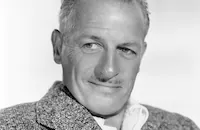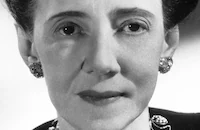Bulldog Drummond's Secret Police

Brief Synopsis
Cast & Crew
James Hogan
John Howard
Heather Angel
H. B. Warner
Reginald Denny
E. E. Clive
Film Details
Technical Specs

Synopsis
On the eve of British detective Hugh Drummond's fifth attempt to wed Phyllis Clavering, one of his house guests, Professor Downie, is murdered after he discovers the location of a treasure buried during the reign of King Charles in a subterranean cavern of Rockingham Tower. When Phyllis is mysteriously spirited away by murderer Borjei Islanyani, who has been masquerading as her butler Albert Boulton, Drummond, his butler, Tenny, and his guests, Algy Longworth and Colonel Nielson of Scotland Yard, descend into the honeycombed tunnels of Drummond's estate to rescue her. The tunnels are riddled with medieval traps worthy of a chamber of horrors, and in one of these, Borjei imprisons the detectives by lowering a set of iron bars. As vicious spikes descend to crush the detectives, Phyllis frees her rescuers by reversing the wheels of the ancient contraption. In the ensuing struggle, the flood gates open and sweep Borjei into the surging waters of the Thames River. The murderer thus disposed of, Phyllis and "Bulldog Drummond's secret police" then climb to safety and are about to resume the wedding festivities when the castle ceiling collapses and Phyllis beats a hasty exit.

Director
James Hogan
Cast

John Howard

Heather Angel

H. B. Warner

Reginald Denny

E. E. Clive

Elizabeth Patterson

Leo Carroll
Forrester Harvey
Clyde Cook
David Clyde
Neil Fitzgerald
Elspeth Dudgeon
Gerald Rogers
Dutch Hendrian
Jimmy Aubrey
Dave Thursby
Dick Rush
Wyndham Standing
Crew
Hans Dreier
George Dutton
Mel Epstein
A. E. Freudeman
Merritt Gerstad
Earl Hedrick
William Lebaron
Edward T. Lowe
Russell Mathews
Boris Morros
Glenn Rominger
Arthur Schmidt
Garnett Weston

Film Details
Technical Specs

Articles
Bulldog Drummond's Secret Police
One of the recurring plot elements in Paramount's series is Drummond's inability to get to the altar with Phyllis. This time he's chosen the family manse, Rockingham Tower, for the occasion. It doesn't take long for one of the guests to unearth a long lost treasure and get himself killed. When the killer kidnaps Phyllis, Drummond, Col. Nielson, best friend Algy (Reginald Denny) and butler Tenny (E.E. Clive) join forces as what Nielson calls a "secret police" to free the damsel in distress. That means searching the maze-like caverns beneath the estate and braving the many booby traps found there.
The gentleman adventurer was the brainchild of Herman C. McNeile, who wrote Bulldog Drummond in 1920. At the end of the first novel Drummond married his client, Phyllis, though in the books her surname was Benton, a name changed to Clavering at Paramount. McNeile wrote ten novels in all before his death in 1937, at which point his friend Gerald Fairlie kept the series going. McNiele and Gerald du Maurier adapted the first novel to the stage in 1921, with du Maurier taking on the title role. In 1922, the character moved to the screen, with Carlyle Blackwell starring in a British silent. Samuel Goldwyn picked up the rights in 1929, casting Ronald Colman as Bulldog Drummond and Joan Bennett as his amorous client in an adaptation of the first novel.
Paramount picked up the rights to the character in 1937, slating him for a series of B-movie appearances. Howard, who had played Colman's brother in Lost Horizon (1937), took on the key role in Bulldog Drummond's Revenge (1937), though he had to cede top billing to John Barrymore, who played Col. Nielson in three of the films. When Barrymore wasn't around, the role went to Guy Standing once then fell into Warner's capable hands. Howard appeared in all but one of Paramount's films in the series, with Ray Milland filling in for Bulldog Drummond Escapes (1937). Phyllis changed just as much, with the role played by Louise Campbell in three films and Angel in five. The only true constant elements were Denny and Clive, who appeared in all of the studio's Drummond films.
Bulldog Drummond's Secret Police was the second screen adaptation of McNiele's sixth Drummond novel, Temple Tower. The story was first filmed at Fox in 1930 with Kenneth MacKenna in the lead. As in the novel, the earlier film omits Drummond's standard supporting cast -- Phyllis, Col. Nielson, Algie and Tenny -- to focus on Marceline Day as a young woman out to avenge her uncle's murder by criminal mastermind Blackton (Henry B. Walthall). Unlike the novel, however, the first film moves the setting to London. There are no surviving prints of the film at this time. The later version returns to the family manse while adapting the plot to feature the recurring characters associated with the Paramount series.
The film features one notable name in the supporting cast, Leo G. Carroll (billed without his middle initial) as Phyllis' sinister new butler. Though he plays his part as capably as ever, his character has generated a good deal of criticism among fans. Carroll is revealed from the start to be the murderous criminal behind all of the plot complications, robbing the film of any sense of mystery. Fans also complained that the insertion of flashbacks depicting Drummond's other attempts to marry Phyllis do little to disguise the fact that even at 56 minutes, the film is heavily padded. Fortunately, the sequences in the tunnel are among the best in the series, with some truly suspenseful moments as Drummond and his "secret police" face the underground booby traps.
Director: James P. Hogan
Producer: Stuart Walker
Screenplay: Garrett Wilson
Based on the novel Temple Tower by Herman C. 'Sapper' McNeile Cinematography: Merritt B. Gerstad
Score: Boris Morros
Cast: John Howard (Captain Hugh C. 'Bulldog' Drummond), Heather Angel (Phyllis Clavering), H.B. Warner (Colonel Nielson), Reginald Denny ('Algy' Longworth), E.E. Clive ('Tenny' Tennison), Elizabeth Patterson (Aunt Blanche), Leo G. Carroll (Henry Seaton)
By Frank Miller

Bulldog Drummond's Secret Police
Quotes
Trivia
Notes
In 1930, Fox produced Temple Tower, directed by Donald Gallaher and starring Kenneth MacKenna and Marceline Day, which was also based on the McNeile book (see AFI Catalog of Feature Films, 1921-30; F2.5552). For more information about the Bulldog Drummond character, consult the Series Index and entries for Bulldog Drummond Strikes Back and Bulldog Drummond Escapes.














